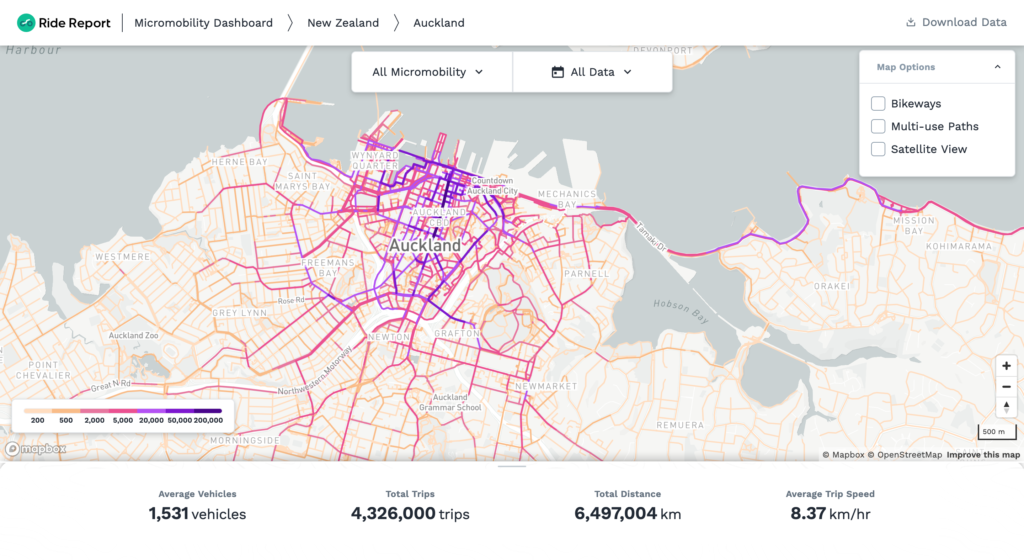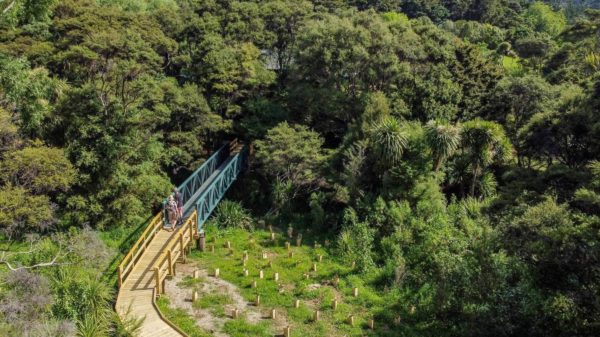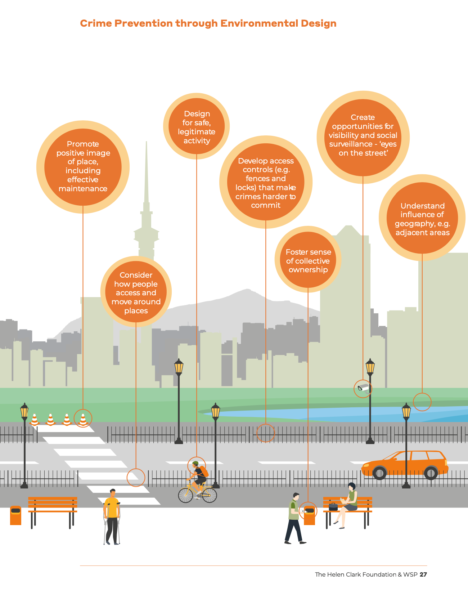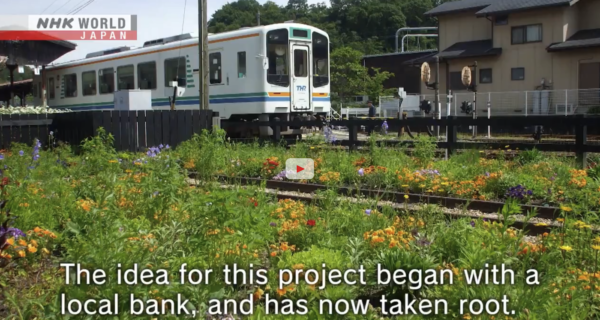Ata mārie, and happy Rāmere. Welcome to a rainy-day roundup.
The week in Greater Auckland
On Monday, Matt wrote a back-to-basics explanation of how transport investment shapes the way people travel, in response to some frustrating arguments in Auckland Council’s first meeting of the new term.
Tuesday’s post spelled out a few big ideas to help get Council through its $270 million operational budget shortfall.
Wednesday’s post followed that with a few more revenue raising ideas, focusing on the levers of parking and traffic fines.
Yesterday, Matt wondered if there are any good reasons to extend the Wynyard Tram.
Getting around in Tāmaki
The Wai Horotiu Queen Street pilot project is nearly finished, just in time for summer. We’re enjoying the extra breathing room for pedestrians, scooters and bikes. It’s a taste of a possible car-free future Queen Street. Here’s a great shot of the footpath extension from up above:
— Jeff Thomson (@jeffcthomson) November 6, 2022
Speaking of scooters, the Auckland Microbility Dashboard is live! This fantastic tool compiles data from bike and scooter share companies to show us where people are using shared micromobility to get around.
A few popular routes stand out straight away – Tāmaki Drive! Dominion Road! – and the central section of Queen Street is our busiest stretch for shared bikes and scooters. The “heart of the scooty”, you might say.

Still speaking of scooters, which part of the street should they be using? Living Streets Aotearoa took Waka Kotahi to court recently over the Agency’s ruling that e-scooters should be allowed on footpaths, but their bid wasn’t successful. The group, who have concerns about scooters making footpaths less safe for disabled people in particular, argued that many footpaths aren’t wide enough for scooters and pedestrians to share.
They’re now hoping that forthcoming Accessible Streets legislation will rule that scooters should be allowed in bike lanes. Speaking of which, it’s two and a half years since Accessible Streets was publicly consulted on. When is the legislation forthcoming?
Good changes take time – and people
We can’t wait to head out west to check out the Matuku Link: a new accessible walkway through a 37-hectare area of regenerating native wetland and forest, en route to Bethells Beach. Originally run by local volunteers, the project was picked up by the Government’s Jobs for Nature programme.
The new track stretches around and through the bush for around a one-and-a-half kilometres, allowing those in a wheelchair or using a walking stick to experience what everyone else could experience readily.

Another regeneration project, the Puhinui Stream, has rangatahi at the heart of its design. Stuff reports on the Youth Lab, a collaboration between Council’s Southern Initiative and Manurewa High school, which brings young people in to work on real projects in council.
High school graduate Matalena Fale worked with council staff and community on an intergenerational strategy for regenerating the Puhinui Stream.
Learning about co-design was an unexpectedly wonderful part of the programme, Fale said. Not everyone in her life understands it, some even ask her whether she’s building houses now.
“Co-design is participatory design,” she explained. “It involves our community, our rangatahi, focusing on a particular issue we’re facing.
“What amazes me about co-design is we approach [the issue] with the voices of our community in the centre of it all.”
Change feels slow, but one day you zoom out and realise it really is happening. The data is clear: the changes in Auckland’s Unitary Plan to allow more housing in the city are having a real effect on keeping rents relatively affordable.
6 years in the making – Auckland's rents are now lower in real terms then they were at the time of upzoning in December 2016. The rest of the country is up over 10% of the same period. A short thread. pic.twitter.com/pXxssJbAgX
— One Final Effort (@1finaleffort) November 5, 2022
Traffic’s back!
In less heartwarming news, it seems that traffic is back: congestion has returned to pre-pandemic levels, according to Stuff. And that’s despite work-from-home numbers remaining high. There’s no denying that COVID-19 has changed the way people travel in their day-to-day lives, but there’s plenty of hypothesis in the article.
Tim Welch from the University of Auckland’s Future Cities research hub says: “At this point we don’t really have hard evidence of what this behavioural shift is.
[…] Welch recalls people raving about how wonderful it was to have no cars on the road during Government restrictions on non-essential travel. So many went on to get back into their cars.
“Everyone’s memory is pretty short-term,” he says.
Traffic is definitely back in Glen Eden, which sounds like its experiencing more car chaos than usual. What’s going on out there?
Glen Eden has to be a contender now for the most messed-up traffic in Auckland now. Cars driving on the wrong side of the road every morning to take shortcuts through carparks. Two lanes of traffic squeezing into single lanes. Footpaths so narrow they're basically single file.
— Dan (@danxduran) November 8, 2022
To cap off this boring traffic segment (trust us, we’d rather talk about pretty much anything else), can we talk about red-light running? Going by this clip, it’s as bad as ever at the notorious intersection of Union and Nelson St.
https://twitter.com/AlecTang_/status/1589850928127283200
A reminder that this crossing is on the route of hundreds of children at nearby Freeman’s Bay School, who encounter this ten times a week.
It’s four and a half years since The Project did a story about this exact location. Two and a half years since AT reported that a trial of red-light cameras (including at this location) had been effective at reducing red-light running. How’s it going?
Life in Tāmaki as a non-driver
This piece by Amanda Kennedy on The Spinoff about how hard it is to get around when you suddenly can’t drive is powerful and eye-opening. Amanda developed post-COVID epilepsy and is not allowed to drive for at least a year after a seizure, leaving her reliant on public transport to get around.
I was always one of the driving oblivious. My sudden disability has given me a horrifying glimpse into the lives of the people who rely on public transport their whole lives. People who use wheelchairs, who have children in prams, who cycle as much as they can but can’t do dozens of kilometres every day — these people are left adrift. What are non-drivers supposed to do? Just eat shit and suffer? Will this be me?
Better transport choices in Pōneke
This car-free family in Wellington found that their lives were transformed when they were able to take part in an e-cargo bike trial. They used to rely on public transport, and found that the e-bike sped things up significantly.
“Getting to work in the city by bus had been taking about 40 to 45 minutes. That became a 15-minute bike ride.
“We save on public transport costs too – the $40 a week previously spent on buses can instead be set aside to pay for other things, including car share vehicles when we need them. We have easy access to Mevo cars where we live, so that’s a good option if we need it. Over the past month, we have probably used one on about three occasions.”
Getting smart about small changes
From July 2023, all large carparks in France will need to be covered in solar panels. The legislation’s just been passed by the French Senate, and it’s part of a nationwide push to increase France’s renewable energy production.
According to the government, this plan, which particularly targets large parking areas around commercial centers and train stations, could generate up to 11 gigawatts, which is the equivalent of 10 nuclear reactors, powering millions of homes.
Not only are they a good idea, it looks solar panels make parking lots nicer places too. We’ll all be glad of that shade as summers get hotter!
Experienced a car park solar array this summer in France, & it made things *more* pleasant than without the array. Can’t see any excuse why we can’t demand something similar in the UK & throw in the roofs of all commercial buildings whilst we’re at it? https://t.co/Aa6jZb7KCS pic.twitter.com/7isen1dsfz
— Paul Powlesland (@paulpowlesland) November 9, 2022
Clever solutions using existing infrastructure is something we can get behind.
https://twitter.com/grescoe/status/1590367803961667584?t=SJlrsP5HkhnISIiszAv5DA&s=31
Safe streets make for safe cities
The latest report from the Helen Clark Foundation and WSP is all about designing safer cities.
While a review of crime data paints a complex picture, there are challenges to respond to with rising concern about public safety in our cities. Coordinated urban design interventions can help make us feel safer. These will become critically important as our cities become denser and there is more demand for public space.

Report author and WSP Fellow Anne Cunningham spoke to Tova O’Brien on Today FM this week, and made the very good point that cities are always changing – which offers opportunities to continue to improve them.
“There’s a tendency that we think of our cities as done and sort of judge them as good or bad, but city life is always evolving. Even in those places [Melbourne & London] are continually having to stay on top of the most recent research about the different ways that we want to use our cities.”
An example: in Wales, a change to the speed limit on residential streets will not only make them safer, it’ll also save the country millions of pounds due to reduced accidents and injuries. All residential streets in Wales will be 20mph by default, and research from Edinburgh Napier University estimates that the change will save $100m in the first year alone.
The report adds: “Evidence suggests that the health benefits of 20mph are far, far greater than casualty savings alone. They include increased physical activity, and therefore less obesity, less stress and less anxiety, as well as other health benefits such as reduced noise and air pollution.
Guess what else helps make our streets safer? Public transport is 10 times safer than driving. The American Public Tranportation Association has put together a collection of material explaining the role PT can play in helping us reach our Vision Zero goals.
[…] metro areas with higher public transit use — more than 40 annual transit trips per person — have half the traffic fatality rates of areas with fewer than 20 annual transit trips per person. When a metro area increases the annual number of transit trips per person from 20 trips to 40, it translates to people taking just two additional public transit trips per month. Yet this relatively small percentage change in ridership provides a disproportionally larger traffic safety benefit.
The good thing is, we already know about lots of fast, easy and simple interventions that will make streets safer, more comfortable, and more accessible to people on foot and bike. In this StreetFilms video, go for a CitiBike ride around Hoboken, New Jersey, to see what they’ve been doing to make their streets safer for everyone.
The classic street-calming device – and one of our favourites – is of course the hero of people friendly streets: the humble bollard.

Brain candy for transport nerds
We need to have a closer look at what’s happening in Tel Aviv one of these days. Meanwhile, please enjoy this soothing multi-modal avenue.
Sderot Yerushalayim: pedestrians, cyclists and (future) public transportation.
07.11.2022 12:37 #TelAviv #Yafo #Jaffa #bikeTLV #פידתחבורה pic.twitter.com/w4VbXUIjrX
— Thomas Schlijper (@schlijperisrael) November 9, 2022
Japan Railway Journal will keep you busy for a rainy weekend. The series consists of twice weekly shows dedicated entirely to telling stories of different parts of Japan’s railway network. We loved this episode, about the rejuvenation of an old rural train line through creative re-use of its stations. Come for the bakery and pizza parlour and overnight inn, stay for the retirees planting wildflowers alongside the tracks.

Another page that’ll keep you busy if the rain hangs around this weekend is EuroNews’ roundup of the best positive environmental stories of the year so far. It’s their effort to help combat eco-anxiety and make sure the positive stories get aired too.
One cool transport story included is Norway’s goal for Oslo’s public transport system to be entirely electric by the end of 2023.
The transport push entails replacing the city’s diesel-fuelled buses with 450 electric ones. It is hoped the 500 million crown (€48 million) programme will save the city money over the long term.
Got your summer holidays planned? Not keen on a long family road trip? Take some inspiration from this intrepid British family and their old-school bike cargo setup.
Petite sortie familiale (1961).pic.twitter.com/QLx57udZEf
— David Guénel (@davidguenel) November 2, 2022
Kia pai tō wikini, and see you next week!

 Processing...
Processing...
Why is Glen Eden gridlocked? It’s one of the main diversion routes for the Watercare related closure of Atkinson Rd in Titirangi.
Good news it’s okay to have a double cab ute.
“If engineers rather than economists had been driving decarbonisation efforts we’d be in better climate shape”
https://www.rnz.co.nz/national/programmes/afternoons/audio/2018865830/electric-machines-will-solve-our-climate-woes-engineer
Although I am not sure how we increase power generation by 250 percent in 30 years but if it is possible it would be preferrable to the partisan bickering we are enduring.
Sigh. Some good points there, particularly about economists, but who, honestly, does he think he’s representing with this kind of thing?: “I think we’ll solve climate change with electric jet skis and doing donuts in electric utes.”
Never mind that there literally is not enough lithium on earth for his plan either
Its very hard to predict how technology could change. I was listening to Kieth Turner chairman of Transpower on RNZ recently he said he tries to keep ahead of changes in solar panel chemistry. Apparently he wouldn’t rule out that power could be produced for one cent per kilowatt hour in the not to distant future. I expect similar breakthroughs in storage using different materials may be possible.
We need change now and the tech is here already – e-bikes.
All we have to do is reallocate road space to protected cycleways and the job will do itself.
Honestly, why do people want to look to some half imagined tech-fantasy salvation when the answer is already right here?
Writing articles about how it’s basically all fixable if people would just listen is easier than taxing emissions by farmers.
Also, it’s hope to give jobs for tech bros and subsidies for projects by tech bros.
The article on congestion shows that the optimism of many of the anti-PT people might be misplaced.
It appears those working from home are more likely to be those previously taking public transport. So car traffic is getting closer to normal that overall commute numbers.
Unfortunately stats are not linked but I wonder how many people stopped doing early/late starts so rush hour has been compressed again.
Either way the roads are going to fill up with cars in 2023. The missing buses, Track work and PT-backlash mean that PT is not going to be in place to handle the overflow. Expect things to get a lot worse.
Missing safe active mode infrastructure, too. Other cities ramped up their active mode plans and now have much better cities as a result. Had we done so we’d have resilience for the situations we’re facing.
Looking at solar panels over carparks, I recently did a little bit of back of the envelope calculations in response to somebody somebody else suggesting this.
Lifting panels onto supports gives shade/rain cover to the cars underneath and the value of the land should be improved if anything. Only issue I can see is that maintenance might be slightly higher than on a farm (health & safety if a panel falls on a person vs a sheep wandering underneath. You might also have to work around cars when cleaning/repairing panels.
On the plus side, you will use all the generation in the local area without major transmission losses and these sorts of big carparks are easy to get to without having to run new high voltage lines long distances.
Out of interest, I did a comparison on Google maps.
Albany park and ride carpark: https://goo.gl/maps/Syt8F5MMoub8jMZ69
My quick measure is about 30,000 sqm (3 hectares) of carpark. And annoyingly they put up some partial walkway shelters without PV panels, but blew some extra space and money on a sculpture instead.
Compared with a biggish solar farm in Taranaki:
https://www.rnz.co.nz/news/national/445614/new-zealand-s-largest-grid-connected-solar-power-plant-up-and-running
Which (again using Google maps measure tools) occupies a bit less area than the Albany carpark – about 2.5 hectares.
If I was AT, I would lease the air-space above the carpark to an energy company even just to get cheap electricity for the bus station and maybe put in some grunty fast chargers for EV buses to top up between morning and evening peak times. Would improve the carpark with more shade/rain cover so win/win.
What would the downside be, other than maybe AT would spend 3 years on consultants and planning before deciding it would cost $800m and they should just build some roads instead?
Don’t believe the Waka Kotahi website – e-scooters are definitely allowed in cycle lanes; they are allowed on the roadway (including bus and transit lanes) and they are also allowed on a footpath.
Scooters are legally cycles and e-scooters legally are power-assisted cycles. But additionally, they are also wheeled recreational devices.
It comes down to the definitions in the Road User Rule 2004 which are:
cycle—
(a) means a vehicle that has at least 2 wheels and that is designed primarily to be propelled by the muscular energy of the rider; and
(b) includes a power-assisted cycle
power-assisted cycle means a cycle to which is attached 1 or more auxiliary propulsion motors that have a combined maximum power output not exceeding 300 W
wheeled recreational device—
(a) means a vehicle that is a wheeled conveyance (other than a cycle that has a wheel diameter exceeding 355 mm) and that is propelled by human power or gravity; and
(b) includes a conveyance to which are attached 1 or more auxiliary propulsion motors that have a combined maximum power output not exceeding 300W
A scooter has two wheels and is propelled by the rider pushing it along with their foot, so a scooter is a cycle. An e-scooter is a power assisted cycle because as already shown it is a form of cycle to which has been added a motor with a power output less that 300W (unless you have an unusually powerful one).
Cycles are clearly allowed on the road, in cycle lanes and also in bus and transit lanes. (Just not in a Bus Only lane or on a motorway).
But even though they are cycles under that definition the fact that the wheels are smaller than 355mm means they are also wheeled recreational devices and so are allowed on the footpath.
AT tends to also expressly allow them in their newer pedestrian malls so long as they aren’t ridden at reckless speeds; but arguably they might be banned from the older pedestrian malls. But that is unlikely to be a problem as the police are very unlikely to know or care and so wouldn’t enforce that. However, your insurance company might not cover any damage that happens there.
You miss the fact that cycle lanes in NZ have a separate status from general carriageway OR footpath), neither fish nor fowl. So the issue is very much real. What is unreal is that such a small legality has not been fixed for 4+ years now (it never made sense for them to be banned).